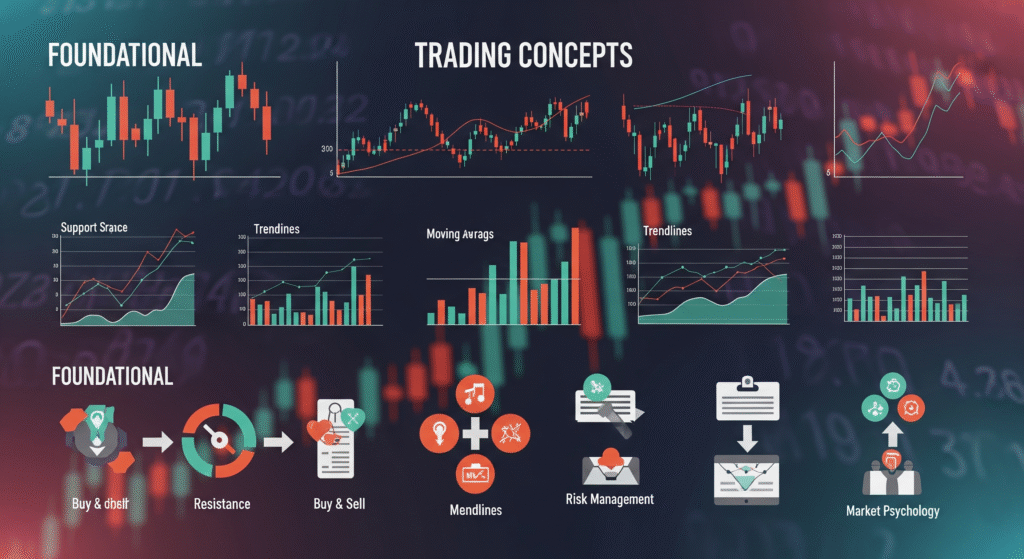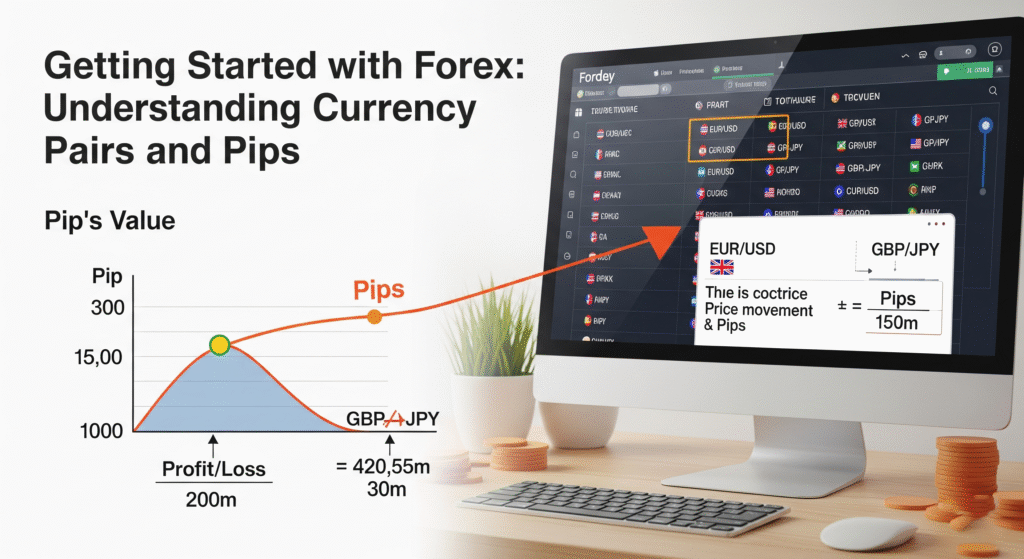He is a Full-time trader and Trading Mentor @ Findependence Trading Academy, with over 18 years of hands-on experience in the stock and forex markets. His journey from being a working professional to achieving financial independence through trading has inspired hundreds of aspiring traders to take control of their financial future.
His trading style revolves around identifying high-probability swing setups in equities and executing precise intraday trades in the forex markets. He treats trading like a business, where rules, clarity, and risk limits aren’t optional—they’re essential. He’s trained over 100+ traders through personalized coaching and structured programs, focusing not just on strategy but on building the mindset and systems that lead to long-term success.
A strong believer in keeping trading simple and practical, He shares real-world lessons drawn from market wins, losses, and years of evolving with changing conditions. He is also the author of “Getting Started with Technical Analysis” and a creator of custom TradingView indicators designed to give traders an edge.
When he’s not charting or mentoring, you’ll find him enjoying a game of Table Tennis.
Table of Contents
CFD vs Futures-Based Prop Firms: A Trader’s Honest Take
If you’ve been poking around the world of proprietary trading, you’ve probably stumbled upon two main types of prop firms: those offering CFD-based trading and others that fund traders using regulated Futures accounts. Both are attractive in their own ways, and both come with a fair share of challenges.
Having been a trader for close to two decades—and seen the evolution from open outcry pits to remote-funded trading—I can tell you this much: the firm you choose to partner with can shape your trading journey more than you think. In this post, I’ll share not just the textbook differences between these models, but the real stuff—the quirks, the hurdles, and the hidden costs that many won’t tell you.
🎯 And if you’re looking to understand all this with clarity and practical depth, explore top-rated forex trading courses near me in Pune to get the edge you need before committing to any prop model.
1. First Things First—What’s the Basic Difference?
Let’s break it down simply:
- CFD (Contract for Difference) prop firms let you trade simulated versions of instruments like forex pairs, indices, commodities, and stocks. You’re not trading the real markets but synthetic prices via brokers or platforms that mimic real market conditions.
- Futures-based prop firms, on the other hand, give you access to actual exchange-traded instruments—NQ, ES, CL, ZB, etc.—on platforms like NinjaTrader or Rithmic.
So yes, the core difference lies in the instrument and the trading environment. But that’s just scratching the surface.
2. Evaluation Models – The Game Before the Game
CFD Prop Firms:
Most well-known CFD prop firms (think FTMO, MyForexFunds, The Funded Trader, etc.) operate on a 2-phase evaluation model:
- Phase 1: Hit a specific profit target (typically 8–10%) within a set number of days (30 days is common) without breaching a drawdown limit (say 10%).
- Phase 2: A more relaxed version—lower target (5%) but with more days (60 days or so).
Pass both? Congratulations, you’re “funded”… sort of.
But here’s the kicker: You’re still trading demo capital. The firm pays out from its revenue, not real trading profits. So it’s more of a performance-based challenge than an investment in your strategy.
Futures Prop Firms:
Here, the process is slightly different. Firms like Topstep, Earn2Trade, and UProfit also run evaluation accounts with fixed profit targets and drawdowns. But the twist?
You’re often required to:
- Trade for a minimum number of days.
- Follow strict daily loss limits and scaling plans.
- Avoid certain behaviors like holding through news events (unless rules allow).
Also, many Futures firms require “consistency”—meaning you can’t make 80% of your profit in one day and coast. Your profits need to be evenly spread out.
If you’re someone who catches a big move and likes to stay flat for days, this rule might drive you nuts.
3. Execution & Platforms – Demo vs Real Feel
CFD Firms:
Execution happens on MetaTrader 4/5, cTrader, or other proprietary platforms.
Pros:
- Familiar UI, especially for forex traders.
- Tight spreads (thanks to synthetic pricing).
- Wide range of assets (from USDJPY to NASDAQ to Gold).
Cons:
- Demo environment. So you may not feel the real slippage or liquidity issues you’d see in live markets.
- Some firms may manipulate spreads or execution delays during news—though most top-tier firms don’t indulge in this anymore.
Futures Firms:
You’re using professional platforms like NinjaTrader, Tradovate, or Bookmap—plugged into live market data via Rithmic or CQG.
Pros:
- Real exchange behavior. You see how bids/asks stack, where volume sits, and how price reacts.
- Cleaner price action with fewer wicks and fake-outs.
- More advanced tools for footprint, DOM, order flow, etc.
Cons:
- Slightly steeper learning curve.
- Mistakes like trading the wrong contract month or overleveraging can be expensive, even in eval mode.
4. Rules That Trip Most Traders
Here’s where I’ve seen traders—especially those new to prop firms—stumble:
For CFD Prop Firms:
- Max Daily Drawdown (MDD): You lose 5% in one day? Game over.
- Trailing Drawdown: Some firms move your drawdown level up as your balance increases. Sounds fair, but it limits swing trading.
- News Trading Restrictions: You might be stopped out for trading within minutes of major economic events.
Emotions get involved fast. I’ve mentored traders who’ve blown 3 accounts in a week just trying to pass Phase 1. Why? Not because they were bad traders—but because they weren’t good at gaming the evaluation rules.
For Futures Prop Firms:
- Consistency rules are a killer. Imagine making $2,500 in one day and then getting a rejection because you were “inconsistent”.
- Scaling plans: You start with 1 contract, and even after you pass, you’re limited to 2-3 lots until you prove yourself.
- End-of-day liquidation: Forget to close your trade before 4:00 PM CT? Some firms auto-liquidate and fail your account.
You’ve got to be not just a good trader—but a good rule-follower.
5. Payouts and Real Funding – Follow the Money
This is where it gets murky.
CFD Firms:
Once funded, you receive payouts from simulated accounts based on your trading performance. Top firms offer 80–90% of profits.
But remember:
- There’s usually a 14–30 day waiting period.
- You may have to hit a minimum withdrawal threshold.
- If you breach the rules again, your account is gone—and with it, any open profits.
Also, the capital isn’t real. No one is copying your trades in live markets. It’s more of a gamified affiliate business model (and it works well—for them and, potentially, for you).
Futures Firms:
In most cases, after passing the evaluation, you are moved to a real sub-account, and your trades are live.
- The profit split is lower (typically 80/20 in your favor).
- There’s a monthly data fee and sometimes platform costs.
- You’ll often need to prove yourself further before being allowed to scale up to 10 or more contracts.
The pressure is real here—because you’re now live in the market.
6. Which One Is Right for You?
This depends on your psychology, your trading style, and frankly, your stage in the journey.
- If you’re a beginner to intermediate trader with experience in forex or indices, a CFD-based prop firm might be your training ground. Lower cost, faster evaluations, and easier platforms.
- If you’re a more seasoned trader, looking to evolve toward real market structure, manage larger capital, and treat trading like a business, Futures prop firms offer the real deal.
But don’t let your ego make the decision. I’ve known 6-figure traders who still choose CFD firms because of the simplicity and predictability of payouts. And I’ve known Futures traders who swear by the DOM and tick charts and wouldn’t touch CFDs with a 10-foot pole.
7. Real Talk: My Experience
When I first tried a CFD firm back in 2018, it felt like a game. Easy to sign up, rules seemed straightforward—but I blew my first three challenges because I was trading like I would with my real capital: swing entries, loose stops, holding over news. Not a good idea.
Then I tried a Futures prop firm. Passed evaluation after two tries—but the rules stressed me out. I made $1,800 in one trade, only to be told I wasn’t “consistent” enough.
It took me years to align my strategy with the firm’s rules. Today, I use both. For aggressive setups, I use CFD firms. For structured trend days, Futures accounts serve me better.
You don’t have to choose one and discard the other. You just need to know when to use which.
Final Thoughts: Trade Smart, Not Just Hard
At the end of the day, prop firms are not your savior.
They’re tools—vehicles to amplify your skillset. But remember, they’re also businesses, not charities handing out cash.
✅ Understand the model
✅ Choose your firm wisely
✅ And above all—stay disciplined
Don’t treat the evaluation like a game show.
Treat it like a job interview.
Would you show up late to your dream job’s interview?
Then don’t take a random 10-lot trade just to hit the target in 2 days.
Trading is hard. Prop trading is harder.
But if you approach it with discipline, strategy, and patience—it could be the bridge between your skill and true financial freedom.
💡 Want to prepare with the right mindset and skillset?
Join expert-led share market classes near me in Pune and learn how real traders build consistent performance before funding even enters the picture.



